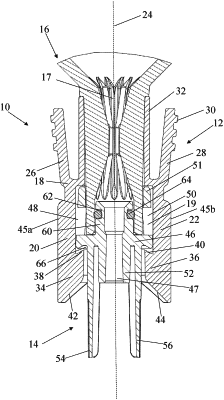| CPC A61J 1/2096 (2013.01) [A61M 5/1782 (2013.01); A61M 39/1011 (2013.01)] | 19 Claims |

|
1. A fluid path connector for a medical fluid delivery system, the fluid path connector comprising:
a first connector element comprising a body, a first lumen, a first flexible leg, a second flexible leg, a first actuating arm associated with the first flexible leg, and a second actuating arm associated with the second flexible leg; and
a second connector element comprising a body defining an undercut having a sloped surface, a second lumen, a channel defined in the body, and at least one sealing element positioned within the channel,
wherein the first flexible leg comprises a first flange and the second flexible leg comprises a second flange, wherein the first flange and the second flange are each angled at an angle from 45-75 degrees relative to a longitudinal axis of the first connector element,
wherein, upon engagement of the first connector element with the second connector element, the first flange and the second flange engage with the sloped surface of the undercut of the body of the second connector element to prevent disengagement of the first connector element and the second connector element,
wherein, upon applying an inwardly-directed pressure to the first actuating arm and the second actuating arm, the first flexible leg and the second flexible leg move in an outward direction relative to the body of the second connector element to disengage the first flange and the second flange from the undercut to allow the first connector element and the second connector element to be disengaged, and
wherein the at least one sealing element is configured to define a fluid tight seal between the second lumen of the second connector element and the first lumen of the first connector element to form a fluid path when the first connector element and the second connector element are engaged with one another.
|